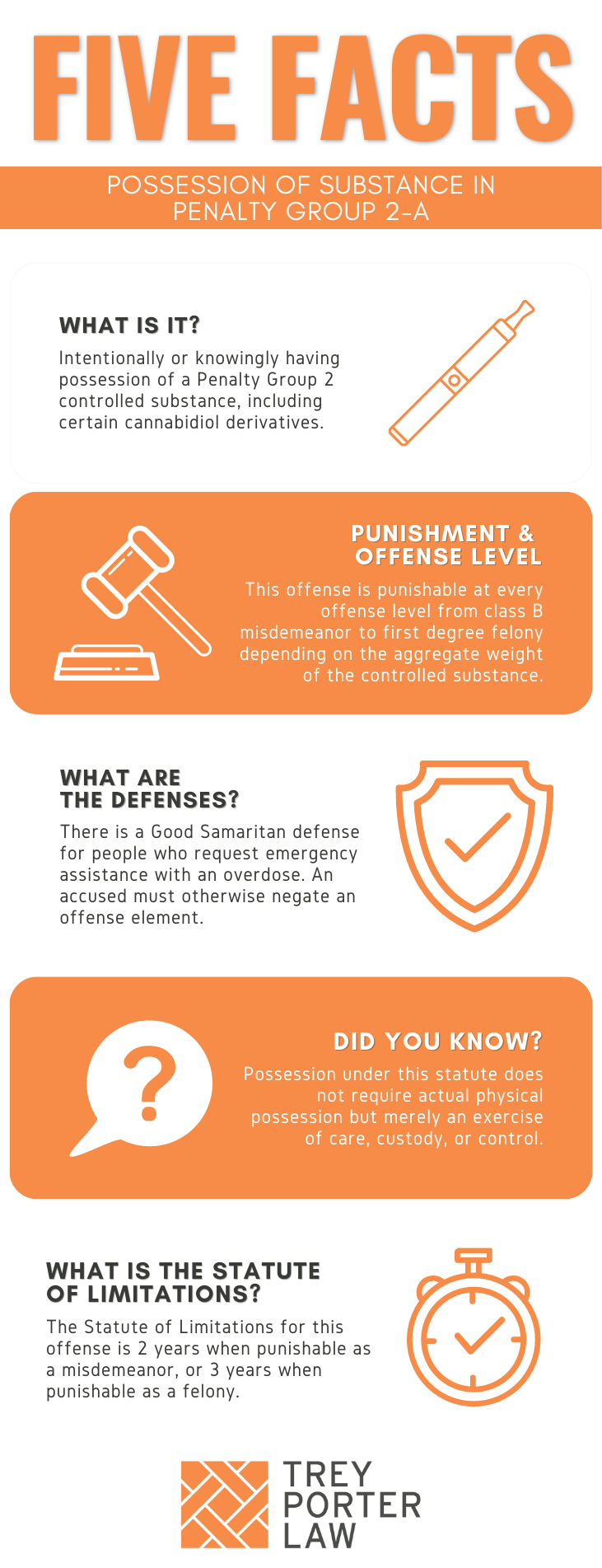WHAT IS POSSESSION OF SUBSTANCE IN PENALTY GROUP 2-A IN TEXAS?
The Texas law against possession of substance in Penalty Group 2-A prohibits having care, custody, or control of a controlled substance listed in Penalty Group 2-A.
- What is a controlled substance? Texas Health and Safety Code Section 481.002 defines a “controlled substance” as a substance, including a drug, listed in Schedules I through V or Penalty Group 1, 1-A, 1-B, 2, 2-A, 3, or 4. The term includes the aggregate weight of any mixture, solution, or other substance containing a controlled substance, but does not include “hemp” as defined by Texas Agriculture Code Section 121.001, or the tetrahydrocannabinols in hemp.
- What is the difference between Schedules I, II, III, IV, and V and the penalty groups of controlled substances? Controlled substances are divided into five “schedules” based on potential for abuse or addiction, which dictate the rules medical professionals must follow in prescribing medications listed in each schedule. Schedule I, for example, are the most addictive substances, and may generally not be prescribed. Substances in Schedule I are also typically in Penalty Group 1, and are considered illegal under most circumstances.Controlled substances are divided into “penalty groups” for determining criminal classification and penalties.
- What controlled substances are in Penalty Group 2-A in Texas? Texas Health and Safety Code Section 481.1031 explains Penalty Group 2-A consists of any material, compound, mixture, or preparation that contains any quantity of a natural or synthetic chemical substance, including its salts, isomers, and salts of isomers, listed by name in this subsection or contained within one of the structural classes defined in this subsection:
- WIN-55,212-2;
- Cyclohexylphenol: any compound structurally derived from 2-(3-hydroxycyclohexyl)phenol by substitution at the 5-position of the phenolic ring, (N-methylpiperidin-2-yl)alkyl, (4-tetrahydropyran)alkyl, or 2-(4-morpholinyl)alkyl, whether or not substituted in the cyclohexyl ring to any extent, including:
- JWH-337;
- JWH-344;
- CP-55,940;
- CP-47,497; and
- analogues of CP-47,497;
Penalty Group 2-A also includes:
- cannabinol derivatives, except where contained in marihuana, including tetrahydro derivatives of cannabinol and 3-alkyl homologues of cannabinol or of its tetrahydro derivatives, such as:
- Nabilone;
- HU-210; and
- HU-211;
- (4) Tetramethylcyclopropyl thiazole: any compound structurally derived from 2,2,3,3-tetramethyl-N-(thiazol-2-ylidene) cyclopropanecarboxamide by substitution at the nitrogen atom of the thiazole ring, whether or not further substituted in the thiazole ring to any extent, whether or not substituted in the tetramethylcyclopropyl ring to any extent, including:
- A-836,339;
- any compound containing a core component substituted at the 1-position to any extent, and substituted at the 3-position with a link component attached to a group A component, whether or not the core component or group A component are further substituted to any extent, including:
- Naphthoylindane;
- Naphthoylindazole (THJ-018);
- Naphthyl methyl indene (JWH-171);
- Naphthoylindole (JWH-018);
- Quinolinoyl pyrazole carboxylate (Quinolinyl fluoropentyl fluorophenyl pyrazole carboxylate);
- Naphthoyl pyrazolopyridine; and
- Naphthoylpyrrole (JWH-030);
- any compound containing a core component substituted at the 1-position to any extent, and substituted at the 2-position with a link component attached to a group A component, whether or not the core component or group A component are further substituted to any extent, including:
- Naphthoylbenzimidazole (JWH-018 Benzimidazole); and
- Naphthoylimidazole;
- (7) any compound containing a core component substituted at the 3-position to any extent, and substituted at the 2-position with a link component attached to a group A component, whether or not the core component or group A component are further substituted to any extent, including:
- Naphthoyl benzothiazole; and
- any compound containing a core component substituted at the 9-position to any extent, and substituted at the 3-position with a link component attached to a group A component, whether or not the core component or group A component are further substituted to any extent, including Naphthoylcarbazole (EG-018).
WHAT IS THE POSSESSION OF SUBSTANCE IN PENALTY GROUP 2-A LAW IN TEXAS?
Tex. Health & Safety Code § 481.1161. POSSESSION OF SUBSTANCE IN PENALTY GROUP 2-A.
(a) Except as authorized by this chapter, a person commits an offense if the person knowingly possesses a controlled substance listed in Penalty Group 2-A, unless the person obtained the substance directly from or under a valid prescription or order of a practitioner acting in the course of professional practice.
(b) An offense under this section is:
(1) a Class B misdemeanor if the amount of the controlled substance possessed is, by aggregate weight, including adulterants or dilutants, two ounces or less;
(2) a Class A misdemeanor if the amount of the controlled substance possessed is, by aggregate weight, including adulterants or dilutants, four ounces or less but more than two ounces;
(3) a state jail felony if the amount of the controlled substance possessed is, by aggregate weight, including adulterants or dilutants, five pounds or less but more than four ounces;
(4) a felony of the third degree if the amount of the controlled substance possessed is, by aggregate weight, including adulterants or dilutants, 50 pounds or less but more than 5 pounds;
(5) a felony of the second degree if the amount of the controlled substance possessed is, by aggregate weight, including adulterants or dilutants, 2,000 pounds or less but more than 50 pounds; and
(6) punishable by imprisonment in the Texas Department of Criminal Justice for life or for a term of not more than 99 years or less than 5 years, and a fine not to exceed $50,000, if the amount of the controlled substance possessed is, by aggregate weight, including adulterants or dilutants, more than 2,000 pounds.
(c) It is a defense to prosecution for an offense punishable under Subsection (b)(1) or (2) that the actor:
(1) was the first person to request emergency medical assistance in response to the possible overdose of another person and:
(A) made the request for medical assistance during an ongoing medical emergency;
(B) remained on the scene until the medical assistance arrived; and
(C) cooperated with medical assistance and law enforcement personnel; or
(2) was the victim of a possible overdose for which emergency medical assistance was requested, by the actor or by another person, during an ongoing medical emergency.
(d) The defense to prosecution provided by Subsection (c) is not available if:
(1) at the time the request for emergency medical assistance was made:
(A) a peace officer was in the process of arresting the actor or executing a search warrant describing the actor or the place from which the request for medical assistance was made; or
(B) the actor is committing another offense, other than an offense punishable under Section 481.115(b), 481.1151(b)(1), 481.116(b), 481.117(b), 481.118(b), or 481.121(b)(1) or (2), or an offense under Section 481.119(b), 481.125(a), 483.041(a), or 485.031(a);
(2) the actor has been previously convicted of or placed on deferred adjudication community supervision for an offense under this chapter or Chapter 483 or 485;
(3) the actor was acquitted in a previous proceeding in which the actor successfully established the defense under that subsection or Section 481.115(g), 481.1151(c), 481.116(f), 481.117(f), 481.118(f), 481.119(c), 481.121(c), 481.125(g), 483.041(e), or 485.031(c); or
(4) at any time during the 18-month period preceding the date of the commission of the instant offense, the actor requested emergency medical assistance in response to the possible overdose of the actor or another person.
(e) The defense to prosecution provided by Subsection (f) does not preclude the admission of evidence obtained by law enforcement resulting from the request for emergency medical assistance if that evidence pertains to an offense for which the defense described by Subsection (c) is not available.
WHAT IS THE PENALTY CLASS FOR POSSESSION OF SUBSTANCE IN PENALTY GROUP 2-A IN TEXAS?
The penalty classification for manufacturing or delivering a controlled substance in Penalty Group 2-A depends on the aggregate weight of the controlled substance in the person’s possession.
- Class B misdemeanor, punishable by up to 180 days in county jail, if:
- the aggregate weight was two ounces or less;
- Class A misdemeanor, punishable by up to one year in county jail, if:
- the aggregate weight was four ounces or less but more than two ounces;
- State jail felony, punishable by 180 days to two years in a state jail facility, if:
- the aggregate weight was 5 lbs or less but more than four ounces;
- Third degree felony, punishable by two to ten years in prison, if:
- the aggregate weight was 50 lbs or less but more than 5 lbs;
- Second degree felony, punishable by two to 20 years in prison, if:
- the aggregate weight was 2,000 lbs or less but more than 50 lbs;
- First degree felony, punishable by five to 99 years or life in prison, if:
- the aggregate weight is over 2,000 lbs.
Texas Health and Safety Code Section 481.134 increases the minimum prison sentence by five years and doubles the fine for possession of a controlled substance in Penalty Group 2-A categorized as a felony, other than a state jail felony, if the offense was committed in a “drug-free zone.” If the offense was a state jail felony committed in a drug-free zone, the penalty classification is increased to a third degree felony.
- What is a drug-free zone in Texas? Texas Health and Safety Code Section 481.134 describes a drug-free zone as:
-
- in, on, or within 1,000 feet of premises of a school (including a day-care center), of premises owned, rented, or leased by an institution of higher learning, the premises of a public or private youth center, or a playground;
- on a school bus; or
- in, on, or within 1,000 feet of premises owned, rented, or leased by a general residential operation operating as a residential treatment center.
WHAT IS THE PUNISHMENT RANGE FOR POSSESSION OF SUBSTANCE IN PENALTY GROUP 2-A IN TEXAS?
The punishment range for possession of a controlled substance in Penalty Group 2-A corresponds to the penalty classification, which depends on the aggregate weight of the controlled substance.
- Over 2,000 pounds (first degree felony):
- five to 99 years or life in prison, maximum $50,000 fine;
- 50 pounds to 2,000 pounds (second degree felony):
- two to 20 years in prison, maximum $10,000 fine;
- 5 pounds to 50 pounds (third degree felony):
- two to ten years in prison, maximum $10,000 fine;
- 4 ounces to 5 pounds (state jail felony):
- 180 days to two years in a state jail facility, maximum $10,000 fine;
- 2 ounces to 4 ounces (Class A misdemeanor):
- up to one year in jail, maximum $4,000 fine;
- 2 ounces or less (Class B misdemeanor):
- up to 180 days in jail, maximum $2,000 fine.
WHAT ARE THE PENALTIES FOR POSSESSION OF SUBSTANCE IN PENALTY GROUP 2-A IN TEXAS?
A person charged with possession of a controlled substance in Penalty Group 2-A may be eligible for probation after a conviction, or deferred adjudication without a conviction. The term of community supervision for possession of PG 2-A charged as a Class A or Class B misdemeanor may not exceed two years.
Community supervision is mandatory for a person convicted for the first time of possession of a controlled substance as a state jail felony. The community supervision term is between two and five years, with the possibility of extending supervision for up to ten years.
The period of deferred adjudication for a third degree felony possession of a controlled substance in PG 2-A charge may not exceed ten years, and the probation period may range from two and five years. If charged with a second degree felony or first degree felony possession of a controlled substance in PG 2-A, the maximum supervision period is ten years.
WHAT ARE THE DEFENSES TO POSSESSION OF SUBSTANCE IN PENALTY GROUP 2-A IN TEXAS?
Texas Health and Safety Code Section 481.123 provides a defense to a person charged with manufacturing, delivering, or possessing a controlled substance if the substance was approved as a new drug by the FDA, or was exempt by the FDA for investigational use.
The statute authorizes a Good Samaritan defense for a person accused of possessing four ounces or less of a controlled substance in Penalty Group 2-A, if the person was the first to request emergency medical assistance in response to an ongoing possible overdose of the person or another, stayed until first responders arrived, and cooperated with medical and law enforcement personnel.
- What is the Good Samaritan defense in Texas? The Good Samaritan defense to prosecutions for possessing four ounces or less of a controlled substance in Penalty Group 2-A is available if the person was the first to request emergency medical assistance in response to an ongoing possible overdose of the person or another, stayed until first responders arrived, and cooperated with medical and law enforcement personnel.A person accused of possession of a controlled substance may only benefit from the Good Samaritan defense if the person was the first to call 911, and cooperated with first responders upon arrival. The Good Samaritan defense is not available if the police were executing a search warrant at the time of the offense, if the accused was committing an additional offense, or if the accused has prior drug convictions.If the accused has successfully raised the Good Samaritan defense in a previous case, or called 911 for an overdose within the 18-month period preceding the instant offense, the person may not raise the Good Samaritan defense at a subsequent trial for possession of a controlled substance.
- Is a lab test required in drug cases in Texas? Generally, yes. A person should not be convicted of possessing, manufacturing, or delivering a controlled substance in a specifically alleged penalty group without a lab report verifying the drug was the controlled substance alleged.In Ex parte Saucedo, the defendant was indicted for possession of methamphetamine, a controlled substance in Penalty Group 1. He pled before the lab results were sent to the prosecution, and was sentenced. The lab report revealed the defendant was actually in possession of methylethcathinone, a substance in Penalty Group 2. The Court of Criminal Appeals granted habeas relief, and cautioned all trial attorneys and defendants against pleading without all the evidence.
- What is drug possession in Texas? Texas Health and Safety Code Section 481.002 defines “possession” as actual care, custody, control, or management. Possession does not require proof a person is physically holding the controlled substance.In Rodriguez v. State, No. 04-21-00503-CR, the defendant’s girlfriend let her friend drive the defendant to the store. Police stopped the car while the defendant was in the passenger seat, and found 0.18 grams of methamphetamine in a chewing tobacco tin in the glove box. The officer noticed tobacco around the defendant’s mouth, so he was charged with and convicted of possession of less than a gram of a controlled substance in Penalty Group 1.The appellate court affirmed. The drugs were conveniently accessible to the defendant on his side of the car, they were in a tobacco tin, and the defendant chewed tobacco.
WHAT IS THE STATUTE OF LIMITATIONS FOR POSSESSION OF SUBSTANCE IN PENALTY GROUP 2-A IN TEXAS?
The limitation period for possession of a substance in Penalty Group 2-A categorized as a misdemeanor is two years. If classified as a felony, the limitation period is three years.
POSSESSION OF SUBSTANCE IN PENALTY GROUP 2-A IN TEXAS
Texas law punishes possession of synthetic marijuana, with the severity of the punishment increasing with the amount possessed. Penalty Group 2-A focuses on the positioning of certain molecular components to determine whether the synthetic compound is prohibited.
A “structural class” is any compound containing a core component substituted at the 1-position to any extent, and substituted at the 3-position with a link component attached to a group A component, whether or not the core component or group A component are further substituted to any extent.
TEXAS POSSESSION OF SUBSTANCE IN PENALTY GROUP 2-A COURT CASES
The case law regarding possession of substance in Penalty Group 2-A in Texas illustrates the types of conduct punished by the statute.
- In Carter v. State, the defendant was arrested with fluoro-ADB, a controlled substance in PG 2-A. He argued at trial the State failed to allege and prove the “structural class,” and the specific positions of the core and link components. The defendant was convicted, and the appellate court affirmed. The State is not required to allege the specific compound positions, and expert testimony established the chemical makeup in this case.

















